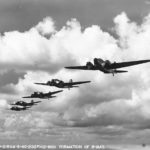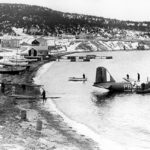B-18A of 27th Reconnaissance Squadron buzzing the USAT American Legion at sea in the Atlantic 26 December 1940
B-18 Bolos at March Field 5 May 1941
Mechanics checking the engine of a B-18 at a base in the Caribbean 1942
B-18A of the 7th Bomb Group at March Field 1939
B-18 and North American BT-9 over Randolph Field
B-18 of 7th BG over downtown San Francisco 17 January 1938
B-18 of the 7th BG over the San Francisco Bay Area 18 September 1938 2
B-18 37-009 and C-47 Albrook Filed, Canal Zone 25 January 1943
Formation of B-18A’s of the 21st Reconnaissance Squadron, April 5, 1940
B-18A of 27th Reconnaissance Squadron over San Juan, Puerto Rico 5 November 1940
459th Ordnance Company men load B-18 with 100-pound practice bombs at Midland Bombardier School
B-18A Bolos of the 38th RS at March Field, 8 April 1939
Allied Officers with B-18 Iceland March 1943
B-18A of the 18th Reconnaissance Squadron over Floyd Bennett Field, NY 4 September 1940
Douglas B-18A of the 18th Reconnaissance Squadron in flight
B-18s over San Quentin California October 1939
B-18A of the 21st Reconnaissance Squadron over Langley Virginia 5 April 1940
Crashed B-18A 37-494 16 April 1943
B-18 of the 7th BG over the San Francisco Bay Area 18 September 1938
B-18 237 and 235 on the flight line at March Field 5 May 1941
Cadet Bombardier with B-18 at Albuquerque Flying School
B-18A and P-40E at Iceland March 1943
Early B-18 at Wright Field
Douglas Digby RCAF 738
B-18 37-01 M1898 75mm gun test
Douglas B-18A #6 37-537 1944
B-18A of the 17th Bomb Group at Felts Field 1940
B-18A bow turret interior details
Douglas DB-2 37-34 in flight 4
Douglas B-18 Bolo frontal view
Douglas B-18 81 in flight 1938
B-18 BS31 of the 19th Bomb Group
B-18 BS2 of the 19th Bomb Group 2
B-18 Bolo nose turret
B-18A Bolo 38-586 Santa Monica
Canadian Douglas Digby RCAF 751 in flight
B-18 bombers of the 5th Bomb Group during exercises near Hawaii
B-18A upper turret exterior details
Douglas B-18 36-262 MAD tests
Douglas B-18 36-343 of the 21st Troop Carrier Squadron in Australia 1943
B-18 Bolo coded RE9
Douglas DB-2 serial 37-34
Douglas B-18A code 75
Douglas B-18 37-01 75mm M1898 gun test
B-18A retrobomb tests 1942
Douglas B-18 at Wright Field 3
B-18A bombers of the 19th Bomb Group over the Grand Canyon 1939
B-18A upper turret exterior
Douglas B-18A Bolo
Douglas B-18 Bolo at Wright Field 2
B-18A 37-503 #14 28 July 1939
B-18A of the 7th Bomb Group 11th Bomb Squadron at March Field
Douglas B-18 of the 21st RS, 1st RG 30 August 1938
B-18A bow turret interior
B-18A of the 1st RG R33 March Field 4 January 1939
B-18 Bolo 88th RS, 1st RG code R65
Douglas B-18 37-01 75mm gun test
Douglas Digby PR-N of the 10.(BR) Squadron RCAF
B-18 1942 Pacific
Douglas DB-2 serial 37-34 3
Bomber Douglas DB-1
Douglas DB-2 37-34 2
Douglas Digby 740 of RCAF
B-18A 37-450 at Santa Monica
Douglas B-18 37-01 75mm M1898 gun test
Douglas DB-1 at Wright Field
B-18 code BE22 of the 5th Bomb Group
Douglas B-18A Bolo serial 37-465 and B-24 Hawaii 1944
B-18A Bolo bomber during Louisiana maneuvers 1941
Crashed B-18 Bolo 37-002 at Hickam Field May 1943
Two B-18 Bolo and B-17 wreck Pearl Harbor
B-18 of the 5th Bomber Group Hickam Field – 7 December 1941 Pearl Harbor
B-18A Bolo formation on anti submarine patrol
B-18A Bolo on the ground Panama 1942
Major Gerald E Williams and B-18 Bolo, Paramaribo Dutch Guiana 1941
Olympic distance runner Louis Zamperini atop B-18A Bolo at Midland Flying School 1943
Douglas B-18B 37-530 with MAD tail antenna and SCR-517A radar
B-18A of the 99th Bombardment Squadron – Caribbean 1942
USAAF Cadet Bombardiers with B-18 Bolo #26 at Albuquerque Flying School 1942
In the early 1930s, the development of military aviation in the United States was severely hampered by the effects of the Great Depression, which led to significant budgetary constraints, as well as widespread pacifist and isolationist sentiments among the American public. The prevailing attitude at the time was to limit the role of the Air Corps to supporting ground forces and coastal defense. The Baker Board, established in 1934 to assess the role of military aviation, even declared that “independent air missions have little effect upon the issue of the battle and none upon the outcome of the war.” This limited view of air power defined the context in which Army officers and War Department officials gathered at Wright Field in 1935 to select the next bomber for the Air Corps.
In May 1934, before the first Martin YB-10, the Air Corps’ first all-metal monoplane bomber, had even been delivered, the Air Corps announced a new competition for multi-engined bombers. These new bombers were required to carry 2,000 pounds (907 kg) of bombs over a distance of at least 1,020 miles (1,640 km) and, if possible, 2,200 miles (3,540 km), with a top speed of at least 200 mph (322 km/h) and ideally 250 mph (402 km/h). In response to this requirement, Douglas Aircraft developed the DB-1 (Douglas Bomber One), a twin-engined bomber based on its successful DC-2 transport aircraft. The DB-1 utilized the wings of the DC-2 but featured a deeper fuselage with a bomb bay, enlarged tail surfaces, and slightly increased wingspan with rounded tips. The aircraft was designed to be operated by a six-man crew and armed with three hand-held 0.30-caliber machine guns.
The DB-1 prototype, powered by two 850-horsepower Wright R-1820-G5 engines, was completed in April 1935 and underwent manufacturer trials before being sent to Wright Field in August 1935 for competitive testing. At Wright Field, the DB-1 was evaluated alongside the Martin 146, an improved version of the B-10, and the Boeing 299, the prototype of the B-17 Flying Fortress. Although the Boeing 299 was faster, had greater range, and carried more bombs, the DB-1 was significantly cheaper, priced at $58,500 compared to the Boeing’s $99,620 per aircraft. The decision ultimately came down to a choice between quality and quantity. The technical staff recommended purchasing a smaller number of Boeing bombers, but the General Staff, favoring the more affordable DB-1, opted for a larger number of these aircraft. The decision was further influenced by the crash of the Boeing 299 prototype, which bolstered the General Staff’s preference for the more conservative procurement approach.
In January 1936, the War Department ordered 133 Douglas B-18s and thirteen Boeing YB-17s. This decision has been widely criticized, both at the time and by later historians, given that the B-17 would go on to become one of the most effective bombers of World War II, while the B-18 was largely obsolete by the time the U.S. entered the war. However, it’s worth noting that even the early B-17 models were considered obsolete by 1941. On the other hand, the availability of a large number of B-18s during the late 1930s allowed the Air Corps to train enough bomber crews for the Army Air Forces, who would later fly the more advanced B-17 models with great success during the war.
The DB-1 prototype, after its evaluation by the Air Corps, was returned to Douglas to be upgraded to the B-18 production standard. It was then delivered back to the Air Corps in February 1937. Two years later, the prototype was modified to test the feasibility of firing large cannons from aircraft. An M1898 75 mm field-piece was mounted in the bomb bay, and the nose of the aircraft was altered to accommodate forward firing. Despite initial trials, excessive vibration when firing the cannon led to the discontinuation of the experiment. However, the lessons learned from these tests were invaluable in the development of later aircraft like the cannon-armed B-25G and B-25H Mitchell bombers. While the cannon-armed B-18 remained experimental, other production versions of the B-18 were produced in significant quantities, contributing to the training and operational readiness of U.S. bomber crews in the lead-up to World War II.
Specifications
variant | B-18 | B-18A |
crew | 6 | 6 |
wingspan (m) | 27,28 | 27,28 |
horizontal stabilizer overall span (m) | 8,128 | 8,128 |
lenght (m) | 17,27 | 17,63 |
height (m) | 4,62 | 4,62 |
vertical stabilizer height (m) | 4,064 | 4,064 |
wing area (m2) | 89,09 | 89,09 |
wing flap area (m2) | 5,96 | 5,96 |
aileron area (m2) | 4,46 (each) | 4,46 (each) |
horizontal stabilizer total area (m2) | 8,90 | 8,90 |
vertical stabilizer area (m2) | 3,52 | 3,52 |
rudder area (m2) | 4,33 | 4,33 |
empty weight (kg) | 7130 | 7403 |
normal take-off weight (kg) | 9584 | 10035 |
max take-off weight (kg) | 12286 | 12552 |
engine | Wright R-1820-45 930 hp at 2100 rpm for take-off, 810 hp at 2100 rpm at 3140 m, air-cooled, radial | Wright R-1820-53 1000 hp at 0m, 850 hp at 2925 m, air-cooled, radial |
propeller | Hamilton Standard Hydromatic, constant speed, 3-bladed, 2,59 m | Hamilton Standard Hydromatic, constant speed, 3-bladed, 2,59 m |
fuel (l) | 4429 | 4429 |
engine oil (l) | 329 | 329 |
max speed (km/h) | 349 at 3050 m | 347 at 3050 m |
cruising speed (km/h) | 269 | 269 |
landing speed (km/h) | 103 | 111 |
ceiling (m) | 7375 – 7878 | 7285 – 7800 |
range (km) | max 3580 | 1850 with 1132 kg bombs |
rate of climb | 6,9 m/s | 5,2 m/s |
climbing time | 9’6” at 3050 m | 9’54” at 3050 m |
bombs (kg) | 1996 | 1996 |
armament | 3×7,62 mm | 3×7,62 mm |
References
- “Douglas B-18 Bolo – The Ultimate Look: from Drawing Board to U-boat Hunter” – William Wolf, Schiffer Publishing
- Dan Hagedorn Sr., Dan Hagedorn Jr – The Douglas B-18 and B-23: America’s Forsaken Warriors, 2015
- Michael O’Leary – DC-3 and C-47 Gooney Birds: Includes the DC-2, DC-3, C-47, B-18 Bolo, B-23 Dragon, the Basler turboprop Goonies, and many more, 1992
- Rene J. Francillon – McDonnell Douglas Aircraft since 1920: Volume 1
Plastic model kits
1/72 Special Hobby SH72095 B-18 Bolo “Pre-War Service”
1/72 Special Hobby SH72228 B-18A Bolo “At War”
1/72 Special Hobby SH72251 Digby Mk.I Bolo in Canadian service
1/72 Special Hobby SH72265 B-18 Bolo “WWII Service”














































































